|
|
|
||
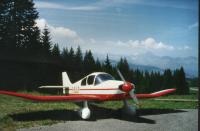
|
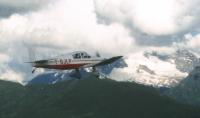
|
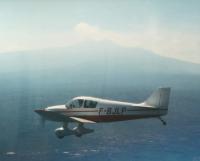
|
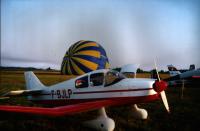
|
|
|
|
|
|
To suit the needs/limitations of users with different Internet access speeds, the pictures are displayed on this page as thumbnails to reduce loading time. Click on the links to see the photo in approx. 1024x700 pixel size (between 50 and 100 kB each). Other picture sizes are accessible via extra links where available.
The first thing you probably think upon arriving at this page is "Why this strange headline? Isn't it a DR.100 or a DR.1050 or whatever?". The answer is yes and no, and has a lot to do with the very special history of this particular aircraft. In its current incarnation as a Jodel DR.1051-M1 Sicile Record it has been owned by Jörg Spittler and Ekkehard Jenne since 1994. But we're getting ahead of the story here. First some photos of the aircraft in question:
|
|
|
||

|

|

|

|
|
|
|
|
|
|
The aircraft with the serial number 25 in the DR.100 series of Jodels first saw the light of day in 1960 as a regular DR.1050 Ambassadeur with Continental O-200 engine. It became special very soon when Pierre Robin selected it as his personal aircraft with the intention to race it in the upcoming 1961 rally around Sicile. Even though this was his first participation in the Sicily rally, Robin flew to a very respectable second place. From now on the aircraft was frequently upgraded to the newest standards. After the last modifications in 1963 to incorporate the swept vertical tail and the all-flying stabilator as well as the then new Potez 4E20 engine, the aircraft was designated as a DR.1051-M1 Sicile Record. Because of these frequent upgrades, this aircraft has changed designations a lot over its lifespan, which is the reason for the 'strange' headline. With this totally French airframe/engine combination Robin won the race around Sicile in 1963 with an average speed of 272 km/h (147 kts) - 'official' red-line speed is 270 km/h! In order to achieve these unbelieveable speeds, Robin had to squeezed everything possible from aircraft and crew: He flew very low over the water to benefit from the drag reduction in ground effect, carried only the minimum amount of fuel required to finish the race and probably ran the engine very hard - after the race in 40 deg. Celsius temperatures, the engine had to be replaced! |
|
After that, the history of F-BJLP becomes a little bit dim. 'LP resurfaced in 1994 when Jörg Spittler and Ekkehard Jenne bought her from Monsieur Lemaire of Grenoble Le Versoud (LFLG), France, for the sum of 110.000 FF. M. Lemaire had used the aircraft frequently to visit his seven children, which live all over France. Ekke and Jörg had heard via a French friend that the aircraft was for sale - it had not even been avdvertised yet. After the sale, they moved the aircraft to Straussberg near Berlin, Germany, where they were studying aerospace engineering at the time. About six months later, while looking through the paperwork that came with the aircraft, they discovered that their aircraft had once been Pierre Robin's personal mount, used by him as a testbed and for racing and always equipped with the latest innovations and 'go-fast' modifications. What a pleasant surprise! During research in the French National Library in Paris, they even found pictures of the aircraft which can be considered final proof of BJLP's ancient history: Pierre Robin and his wife on the wing of the aircraft with the winning trophy of the Sicily Rally around his neck.
Motivated by the rich history of their bird, 'Juliet' received a new instrument panel and a new leather interior in 1995, after Jörg and Ekke had finished their studies. Using their good connections to a machine shop at the TU Berlin, the panel plank and instrument cut-outs were machined there on a CNC mill from a sheet of 2 mm aluminum. The panel and the interior took about three months to complete, after which the whole cockpit was like new. Despite moving the aircrat to Berlin, the aircraft had to remain on the French register. The reason for this is the Potez engine, which was never certified in Germany, so a plane using this engine cannot be certified also. Still, when looking through the DR.100 series aircraft list, one can find 6 or perhaps even 7 aircraft registered in Germany which should have a Potez engine: D-EJZC (s/n 49), D-EJNZ (s/n 169), D-EJWY (s/n 208), D-ELMN (s/n 437), D-ELJR (s/n 468) and s/n 541 (reg. unknown) as well as D-EJYT, of which the serial number is not known at the moment. But all this information is from unverified sources, so it could very well be that those aircraft were converted to the Continental O-200 engine before being imported to Germany, as all were originally registered in France. At the moment, Jörg is in contact with the LBA to check on the possibility of registering a Potez-powered DR.1051 in Germany. |
|
The only remaining problem was the fact that the Potez engine had only about 50 hours left and was already running on a TBO extension. Despite all its idiosyncranies and problems, Jörg considers the Potez to be a good engine. Very well done mechanically, the design is fairly recent in comparison with Lycomings and Continentals. Compared to their colleagues from the 'new world', the engine runs extremely smooth and uniform. Despite bigger displacement, more power and more torque, the Potez weighs about the same as a Continental O-200, about 100 kg (220 lb). This small difference in power output is quite noticeable in cruise performance: with an Evra wood propeller, GPS-confirmed cruise speeds are about 220 km/h (119 kts - my square-tail DR.1050 D-EHIE gets about 100 kts indicated at 2600 RPM with the O-200). At full gross weight of 780 kg (1718 lb), climb rate is still around 4 m/s (787 ft/min). These values should be improvable a little when using a ground-adjustable Ratier propeller, which unfortunately has his own problems - becoming very scarce, having a TBO of only 1000 hours (with the Continental O-200, with the Potez, a TBO was never established) and being a little worse than the wood prop when it comes to vibrations.
The problems with the engine have their roots mainly in two things: like the Ratier propeller, they are getting very scarce. Potez only built 100 of those engines altogether and went bankrupt in the sixties, not long after the introduction of the engine. So spare parts are are few and far between today, and are desperately sought-after by the owners of this engine. The second problem has more everyday consequences, as it can make the engine both interesting and challenging but sometimes also frustrating to operate. I'm talking about the very different ignition system of the Potez when compared to the usual dual magneto ignition of your little Continental. To set themselves apart from their american competitors, the French engineers had to do things differently. Due to lack of experience and only limited service time in service until Potez went bankrupt, the ignition can hardly be called sophisticated. The energy for the coil ignition is supplied by two independent sources: battery-power and power from the generator. Those two sources for spark energy can be seperated like the two magnetos in the usual setup. The execution of this system is technically far from perfect and therefore pretty unreliable. Leakage current and damp or wet operating conditions are often cause for (temporary) ignition system failure. Those 'little problems' require that owners know this installation very well in order to operate it successfully - most of the time. Sometimes even seasoned Potez-owners don't succeed in getting their engine to run, especially during winter conditions. Pre-heating and hand starting are the best bets during those circumstances, but they don't work all the time!
For more info, check out Hans Teijgeler's article on the Potez engine!
| But back to F-BJLP. With only 50 hours remaining on the engine, something had to be done fast. While being on one of their frequent 'Tours de France', Jö and Ekke discovered a shabby-looking DR.1051 Sicile in a corner of the airport of Andernos near Bordeaux in October of 1995. To make up for the not-so-nice exterior, this aircraft (F-BKHQ, s/n 386) had a rather low-time Potez engine installed. Because of lack of knowledge concerning the ignition system of the Potez, the owners were more than willing to sell the aircraft. After spending only a few minutes to get the engine started for a test flight (under the un-believing eyes of members of her previous owners, a flying club), HQ quickly changed hands for 65.000 FF. After flying her for 50 hours, the aircraft was completely disassembled. During about a week of work at Grenoble, HQ's engine found its way into the nose of Juliet with around 1000 hours since new. There it ran reliably until a dreaded date: July 20, 1998. In the mean time, the remaining parts of HQ were transported to and stored in a corner of Ekke's barn, to be used as replacement parts in case of a mishap or in a future (twin-engine!) homebuilt Jodel. |
|
Bild BKHQ ??
|
|
|
|
|
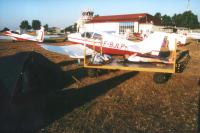
|

|
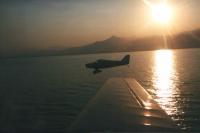
|
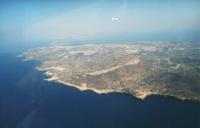
|
|
|
|
|
|
|
|
|||
Until about mid-year 1998, Ekke and Jörg had a lot of fun (and sometimes a little bit of frustration thanks to the Potez' ignition) with their aircraft, nick-named 'Juliet'. But all this changed very sudden on a particular flight. During one of their tours with friends from a Fournier RF-3 club (Jörg also owns one of those together with some friends from Berlin), they were on a trip to Malta. After landing there at the airport of Valetta, the engine suddenly caught fire while taxying back after landing on runway 14. Thanks to the very fast responding fire fighters at the airport, Juliet didn't go the way of so many Jodel aircraft of this type. The fire could be extinguished before the whole airplane spread past the fire wall to the (wooden!) fuselage. After removing the scorched cowling it was found that one of the silencers had developed an egg-sized hole emanating from a crack. The hot exhaust gases escaping through this hole burned through a fuel hose and finally set the engine on fire - thankfully only after the landing! The date was July 20, 1998.
|
|
|
||
| (13) Right: The airport fire fighters at Valetta (Malta) saving Juliet from destruction. |
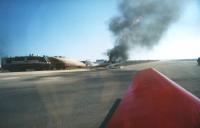
|
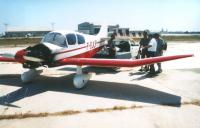
|
(14) Left: After successfully extinguishing the fire, F-BJLP is towed to a hangar for disassembly. |
|
|
|
|
|
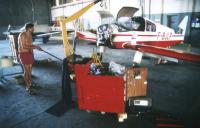
|
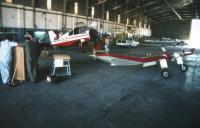
|
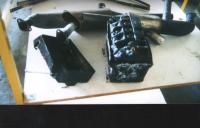
|
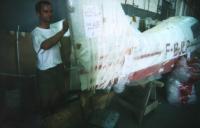
|
|
|
|
|
|
|
|
|||
With the aircraft saved but not flyable any more, it took eight days to disassemble and crate the aircraft to make it ready for a trip to Rotterdam by ship in a 40 foot container. The container arrived in Knittlingen near Bretten in the southwestern part of Germany in September of 1998. After this incident, Ekke decided to buy another Jodel, this time a Capitain. This left/leaves Jörg more or less alone with the repairs to be done, which are definitely too much for his limited spare time. Therefore he is looking for a partner in the aircraft to take over Ekke's share - both of the plane and of the work still involved! Any takers? The aircraft will probably be based at Mainz-Finthen (EDFZ), Germany.
Since arriving in Knittlingen by container, Juliet has been sitting in the barn/shop of Ekke, patiently enduring the repairs. Because the airframe was more or less completely disassembled anyhow, it was decided to use the chance and do a ground up restoration also. The partly burned firewall and the cockpit floor (see pictures 17 to 19) were replaced with new parts by Mr. Huber in Speyer. After that, the fuselage was recovered from the firewall to the door and then painted (see pictures 22 to 24).
|
|
|
|

|
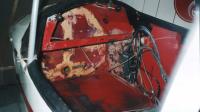
|
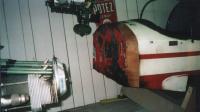
|
|
|
|
|
|
|
||
Juliet will be using more or less all firewall-forward parts from BKHQ, whose airframe was sold in March 2000 to Jodel enthusiast Bernard Tevenot of Luneville, France. In picture 19, both Potez engines that were installed in 'LP are partially visible: the burned engine from F-BKHQ at left, with about 800 hours left until TBO, and the previously installed, almost run-out Potez in the background, still good for an overhaul or as a spare parts source. This winter, the engine work will be done, and the intention is to install a ground-adjustable Ratier propeller to gain a little more cruise speed. As of September 2000, the repair and restoration work is almost done, but there's still a lot to be done until Juliet will take to the air again.
As a side note, there seems to be light at the end of the tunnel for owners of Potez-powered Jodels: Monsieur Olivier at La Rochelle, France, has received approval from the French Bureau Veritas to do overhauls of Potez engines registered under a regular French airworthiness certificate (CDN). Having done this for a number of years for French homebuilt Jodels (CNRA airworthiness certificate), he has collected a surprisingly well-stocked spare parts inventory. Now it is possible to get a Potez overhauled by him for about DM 12.000, including two modifications on the electric starter and the push rods. If you have a Potez-equipped aircraft, you should consider this - and don't wait too long, M. Olivier is already well past seventy, and nobody wants to work forever!
This article was prepared based on information received during e-mail exchanges with Jörg Spittler in September 2000. All photos were also supplied by him, and they as well as this article are copyright (c) 2000 by Jörg Spittler.